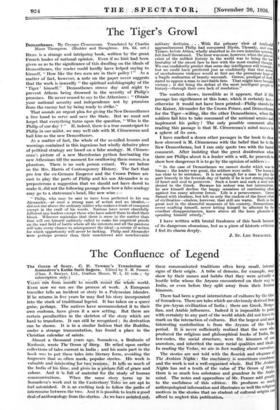The Confluence of Legend
from mouth to m—oa—lCitind. the 7sViinle
Even now we can see the process at work. A- European traveller tells an incident or story to a Polynegian islander. If he returns in five years he may find his story incorporated into the stock of traditional legend. It has taken on a queer guise, perhaps. The natives have accommodated it to their own customs, have given it a new setting. But there are certain peculiarities in the skeleton of the story which are bard to transform. It can still be recognized ; its derivation can be shown. It is in a similar fashion that the Buddha, under a strange transmutation, has found a place in the Christian calendar of saints. • • Almost a thousand years ago, Somadeva, a Brahmin of
Kashmir, wrote The-Ocecin of Story. He relied upon earlier collections of tales current in. India ; and his main part in the book was to put these tales into literary form, avoiding the longueurs that SO, often mark,--popular stories. His work is valuable and interesting` twdreaSons,:. It tells us much of the India of his time, and gives Us a picture full of grace and colour. And it-Is full of material' tor the Study of human communications. When the same story ;turns up in Somadeva's work and in the Canterbury Tales we are apt to feel astonished. It is sn.exciting task to follow the paths of
intercoilise between the two And it is possible to learn a-good deal ofanthmpology- from the.ste■rieS. vre.have pointed441.
these communicated - traditions- often keep small, internal signs of their origin. A tribe of demons, for example, may show by their names and habits that they were actually a hostile tribe whom the Aryans- encountered- -on their way to India, or even before they split away from their Iranian kinsmen: There had been a great intermixture of cultures by the time of Somadeva. There are tales which are obviously derived from the pre-Aryan civilization of India ; there are Greek, Mow• Tian, and Arabic _influences. Indeed it is impossible to POW with certainty to any part of the world which did not leave its mark on the interaction of cultures. But the largest and most interesting contribution is from the Aryans of the Voile period. It is neVer sufficiently realized that the men who produced the religious and philosophical books of India, the la*-codes, the social structure, were the kinsmen of ctle ancestors, and inherited the sane racial qualities and ideals. In reading the Vedas; we ire in fact reading about ourselves. The stories are not told with the, flourish and elegance of The Arabian Nigir,F: machinery is sometimes. cumbrous and the work is not a well-oriaiiiied.whole. But The Arabian Nights has not a tenth of the Value of The 'Ocean of Stay; there is so much less substance and grandeur in the Arabic mind. The notes and appendices of -Mr.- Penzer - add great-1Y to the usefulness of - this- edition; • He produces so ouch anthropological information and illustrates so well the religion motives in- the stories that no student-of cultural origins °an afford to neglect-this publication.






























































 Previous page
Previous page